
Sigmund Romberg was a Hungarian-born American composer. He is best known for his musicals and operettas, particularly The Student Prince (1924), The Desert Song (1926) and The New Moon (1928).

Jeanette Anna MacDonald was an American singer and actress best remembered for her musical films of the 1930s with Maurice Chevalier and Nelson Eddy. During the 1930s and 1940s she starred in 29 feature films, four nominated for Best Picture Oscars, and recorded extensively, earning three gold records. She later appeared in opera, concerts, radio, and television. MacDonald was one of the most influential sopranos of the 20th century, introducing opera to film-going audiences and inspiring a generation of singers.
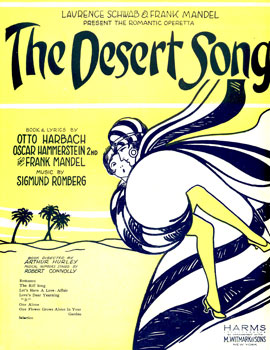
The Desert Song is an operetta with music by Sigmund Romberg and book and lyrics by Oscar Hammerstein II, Otto Harbach and Frank Mandel. It was inspired by the 1925 uprising of the Riffs, a group of Berber fighters, against French colonial rule in Morocco. It was also inspired by stories of Lawrence of Arabia aiding native guerrillas. Many tales romanticizing Saharan North Africa were in vogue, including Beau Geste and The Son of the Sheik.
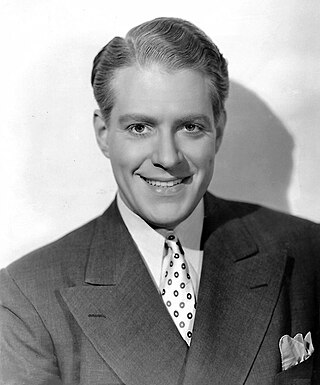
Nelson Ackerman Eddy was an American actor and baritone singer who appeared in 19 musical films during the 1930s and 1940s, as well as in opera and on the concert stage, radio, television, and in nightclubs. A classically trained baritone, he is best remembered for the eight films in which he costarred with soprano Jeanette MacDonald. He was one of the first "crossover" stars, a superstar appealing both to shrieking bobby soxers and opera purists, and in his heyday, he was the highest paid singer in the world.
The New Moon is an operetta with music by Sigmund Romberg and book and lyrics by Oscar Hammerstein II, Frank Mandel, and Laurence Schwab. The show was the third in a string of Broadway hits for Romberg written in the style of Viennese operetta. Set in 1792, shortly before the French Revolution, the story centers on a young French aristocrat in disguise, who has fled his country and falls in love with the daughter of a prominent New Orleans planter.
The Student Prince is an operetta in a prologue and four acts with music by Sigmund Romberg and book and lyrics by Dorothy Donnelly. It is based on Wilhelm Meyer-Förster's play Old Heidelberg. The piece has a score with some of Romberg's most enduring and beautiful tunes, including "Golden Days", "Drinking Song", "Deep in My Heart, Dear", "Just We Two" and "Serenade". The plot has elements of melodrama but lacks the swashbuckling style common to Romberg's other works.

A chorus line is a large group of dancers who together perform synchronized routines, usually in musical theatre. Sometimes, singing is also performed. While synchronized dancing indicative of a chorus line was vogue during the first half of the 20th century, modern theatre uses the terms "ensemble" and "chorus" to indicate all supporting players in a stage production.

Rose-Marie is an operetta-style musical with music by Rudolf Friml and Herbert Stothart, and book and lyrics by Otto Harbach and Oscar Hammerstein II. The story is set in the Canadian Rocky Mountains and concerns Rose-Marie La Flemme, a French Canadian girl who loves miner Jim Kenyon. When Jim falls under suspicion for murder, her brother Emile plans for Rose-Marie to marry Edward Hawley, a city man.
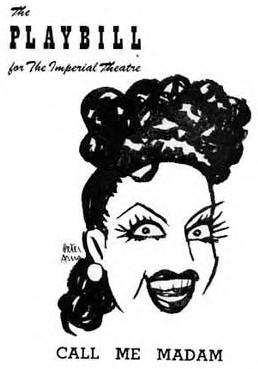
Call Me Madam is a Broadway musical written by Howard Lindsay and Russel Crouse, with music and lyrics by Irving Berlin.

Till The Clouds Roll By is a 1946 American Technicolor musical film produced by Metro-Goldwyn-Mayer. A fictionalized biopic of composer Jerome Kern, portrayed by Robert Walker, Kern was originally involved with the production, but died before its completion. Featuring an ensemble cast of well-known musical stars, it was the first in a series of MGM biopics about Broadway composers.

Maytime is a 1937 American musical and romantic-drama film produced by MGM. It was directed by Robert Z. Leonard, and stars Jeanette MacDonald and Nelson Eddy. The screenplay was rewritten from the book for Sigmund Romberg's 1917 operetta Maytime by Rida Johnson Young, Romberg's librettist; however, only one musical number by Romberg was retained.
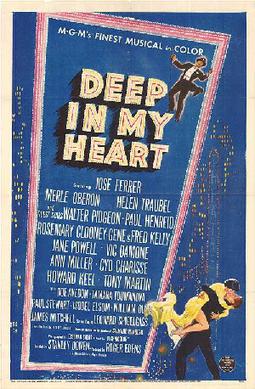
Deep in My Heart is a 1954 American MGM biographical musical film about the life of operetta composer Sigmund Romberg, who wrote the music for The Student Prince, The Desert Song, and The New Moon, among others. Leonard Spigelgass adapted the film from Elliott Arnold's 1949 biography of the same name. Roger Edens produced, Stanley Donen directed and Eugene Loring choreographed. José Ferrer played Romberg, with support from soprano Helen Traubel as a fictional character and Merle Oberon as actress, playwright, librettist, producer, and director Dorothy Donnelly.

Beggar's Holiday is a musical with a book and lyrics by John La Touche and music by Duke Ellington.

Sweethearts is a 1938 American Technicolor musical romance film directed by W.S. Van Dyke and starring Jeanette MacDonald and Nelson Eddy. The screenplay, by Dorothy Parker and Alan Campbell, uses the “play within a play” device: a Broadway production of the 1913 Victor Herbert operetta is the setting for another pair of sweethearts, the stars of the show. It was the first color film for Nelson or Jeanette. It was their first film together without uniforms or period costumes.

New Moon is a 1940 American musical film released by Metro-Goldwyn-Mayer and directed by Robert Z. Leonard, with uncredited direction by W. S. Van Dyke.

The Cat and the Fiddle is a 1934 American pre-Code romantic musical film directed by William K. Howard based on the hit 1931 Broadway musical of the same name by Jerome Kern and Otto A. Harbach, about a romance between a struggling composer and an American singer. The film stars Ramon Novarro and Jeanette MacDonald in her MGM debut.
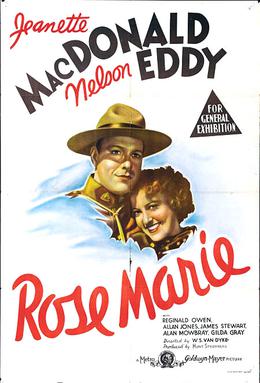
Rose Marie is a 1936 American musical western film starring Jeanette MacDonald, Nelson Eddy, and Reginald Owen that was directed by W. S. Van Dyke. It was the second of three movie adaptations from Metro-Goldwyn-Mayer of the 1924 Broadway musical of the same name. A silent version was released in 1928 and a color film in 1954. All three versions are set in the Canadian wilderness. Portions of Rudolf Friml and Herbert Stothart's original score for the Broadway musical are utilized in both the 1936 and 1954 films.
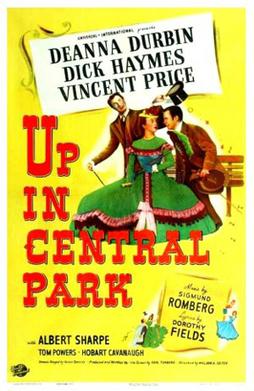
Up in Central Park is a 1948 American musical comedy film directed by William A. Seiter and starring Deanna Durbin, Dick Haymes and Vincent Price. Based on the play Up in Central Park by Herbert Fields with a screenplay by Karl Tunberg, the film is about a newspaper reporter and the daughter of an immigrant maintenance man who help expose political corruption in New York City in the 1870s.

"Indian Love Call" is a popular song from Rose-Marie, a 1924 operetta-style Broadway musical with music by Rudolf Friml and Herbert Stothart, and book and lyrics by Otto Harbach and Oscar Hammerstein II. Originally written for Mary Ellis, the song achieved continued popularity under other artists and has been called Friml's best-remembered work.
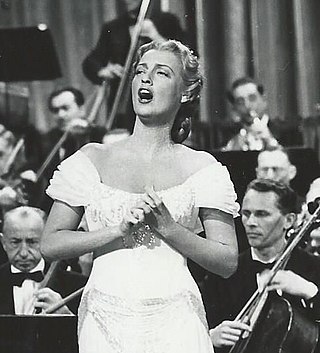
American actress/singer Jeanette MacDonald recorded over 50 songs during her film career for RCA Victor and its foreign counterparts. Due to the limited statistics released to the public, it is not certain how many songs and singles she has released or their exact popularity in music charts, although she has officially recorded eight studio albums and released seven compilation albums. Despite soundtracks for musical films not becoming a concept until the 1940s, many of her singles were re-recordings of songs she had performed in the movies ; her first "album" was the single "Dream Lover"/"March of the Grenadiers" (1930) on 78 rpm discs for The Love Parade. She also recorded a cover album of songs featured in Sigmund Romberg's Up in Central Park in 1945 with Robert Merrill, as well as non-English records during her 1931 European tour.


















